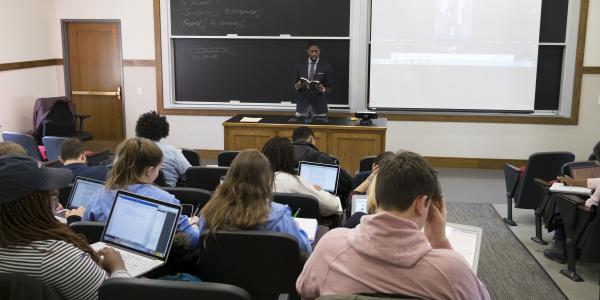On the fifth Monday of each semester, a new source of productive procrastination becomes available: Course Listings go up on WebStac.
I was browsing through the fresh listings in February (the fact that I’m graduating in two months doesn’t stop me), and it occurred to me that these compelling descriptions and book lists do not materialize the day they go up on the website. While I’ve always focused on this day as the creation date, I realized that professors must have finalized the details of their courses long before this point.
I snooped around the “For Faculty & Staff” tab on the Arts & Sciences website for more information, feeling a little rebellious as I explored a part of the website explicitly not for me. However, I didn’t have to look far—the first link under “Additional Information and Links” was “Curriculum Proposal Forms.”
Proposals, it turns out, consist mostly of the syllabus, which tend to be similar to (if not the same as) what professors distribute on the first day. An accompanying form also asks for logistical details, such as expected class size and units of credit. These are due to the Arts & Sciences Curriculum Committee by the first day of the preceding semester—proposals for new classes this coming fall, for example, were due to the Curriculum Committee on the first day of our current semester, giving “syllabus day” a double meaning for many professors.
I reached out to a member of the Arts & Sciences Curriculum Committee to find out more about what happens after proposal submission. The Committee features six professors from departments across Arts & Sciences, including anthropology, physics, and romance languages. Their role is not to approve or reject courses—each department determines internally which courses they would like to offer. Rather, the Curriculum Committee reviews proposals with an eye for big picture issues, such as clear grading rubrics and opportunities for students to receive regular feedback.
This process is strictly for new classes—courses that are taught annually or biannually do not need to be re-reviewed by the Committee. However, if a course has not been offered for a long time, or if the instructor would like to adjust the course in a significant way––such as revising a 200-level course to be 300-level or offering an existing course in a Writing Intensive version––they must bring the proposal back to the Committee for review.
Still eager to find out more beyond the words and numbers, I contacted two professors—one whose class has a long history at WashU, and another whose class is in its very first semester.
Physics of the Heart

In the spring semester of 1975, James Miller, the Albert Gordon Hill Professor of Physics, taught “Physics of the Heart” for the first time. The class explored the basic physics of the human cardiovascular system, applying the principles of physics to understand cardiovascular diseases. This spring, Professor Miller is teaching the class a forty-third time.
He first created the course based on his academic interests. “I wanted to share with Washington University students my excitement about the research I was conducting,” Miller explains. Since then, the core physics have remained the same, but the applications have grown and matured. Miller makes a point of incorporating various new developments in the cardiology field each year.
Miller has also had to adapt to changes in the classroom. In 1975, Miller taught the class using 35mm slide projector. Today, he uses video productions and real-time video demonstrations. Furthermore, student demographics have shifted: now more than half the class is made up of Biomedical Engineers, a major that did not exist when the course began in 1975. However, even forty-three years later, a significant number of students enrolled still plan to attend medical school.
Alternative Facts: An Introduction to the Social Construction of Reality
On January 22, 2017, Kellyanne Conway coined the term “alternative facts” in a Meet the Press interview. It was around this time that Ariela Schachter, an assistant professor of sociology, began thinking about how she might tackle the 2016 presidential campaign in the form of a course. Concerns about “fake news” were proliferate, and they resonated with Schachter’s own research interests in how media coverage and misinformation relate to Americans’ attitudes towards immigration.

She describes her course as having a twofold objective: that it would both “introduce students to how sociologists study the production and consumption of information, and reinforce key media literacy skills that are essential in our current news and political climate,” she says.
Although Schachter had already done much of the reading and research for the foundation of the course, her topic is unique in that it is based on theory that is still being shaped and developed. “A lot of the topics we cover in the course—for example: fake news, media slant, and the role of data science and artificial intelligence—are very active areas of cutting-edge research across multiple disciplines, not just sociology,” Schachter explains. She examined the latest work being done on these topics as she constructed the course, but now that the semester is underway, she stays informed on the most recent findings so that she can share them with her students.
Though Schachter’s personal interests inspired her to create the course, she collaborated closely with her colleagues in sociology to refine her ideas into a course proposal. She hopes to teach the class many more times in the future, updating it with the latest research and its connection to current events which will inevitably influence our perception of this topic. However, it is impossible to predict what it will look like in any subsequent iteration.
“Check back with me next year and I can let you know what I’ve changed!” she says.





